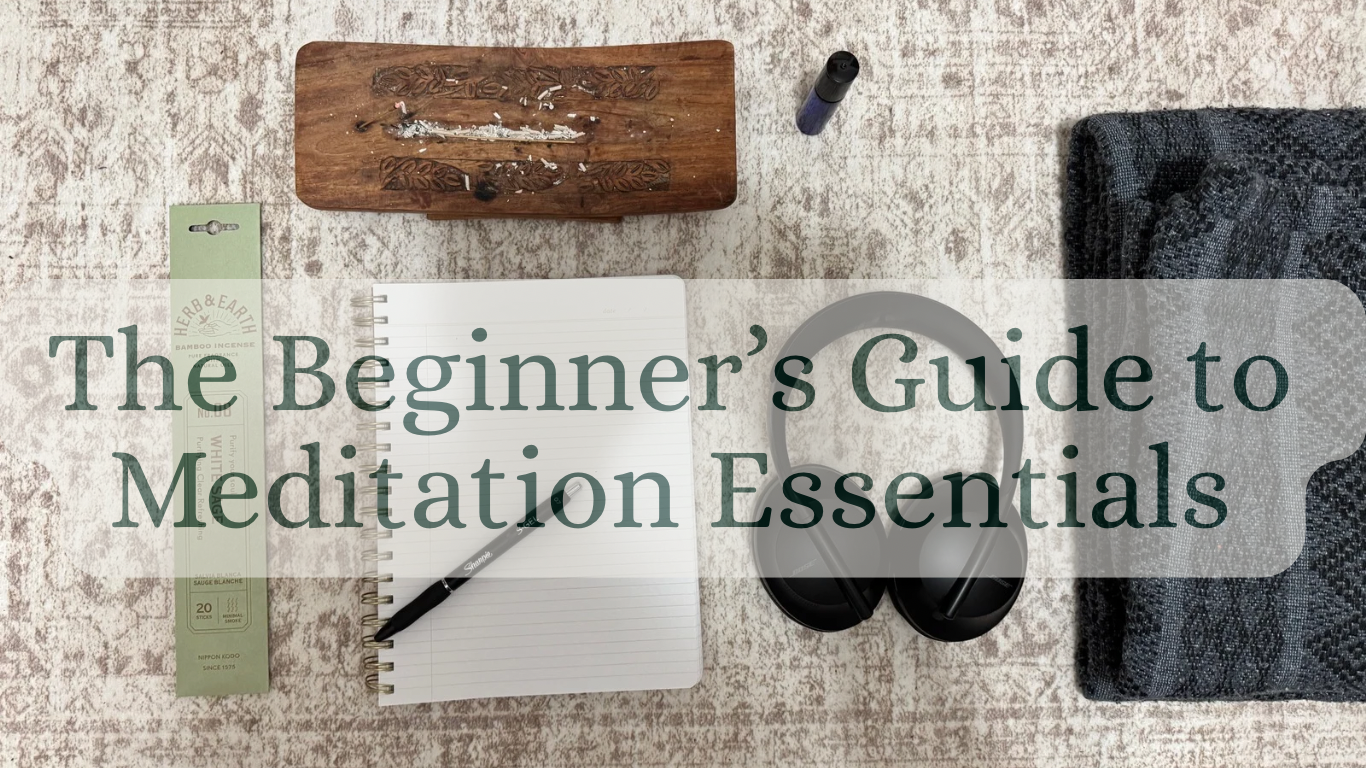Find your calm, one breath (and tool) at a time.
As an Amazon Associate I earn from qualifying purchases.
So you’re thinking about starting a meditation practice? First of all—yay, welcome. If you’re wondering what you actually need to begin, this post covers the key meditation essentials for beginners that can help you ease into the practice with confidence and calm. A few thoughtfully chosen tools can truly enhance how it feels to begin and maintain your meditation journey.
Here are the meditation essentials that helped me go from overwhelmed mom to actually looking forward to my meditation time (yes, really).

1. Meditation Space Setup for Beginners
If you’re even a little anxious about starting meditation, the feeling of being seen or interrupted can totally derail you. Making sure the space is really quiet—and knowing no one is going to barge in—gives you a sense of safety and privacy.
That sense of security allows you to really let go and observe your thoughts without fearing judgment or interruption. Especially for beginners, privacy can be the thing that makes meditation possible at all.
Meditation space tips:
- Choose a corner with minimal noise and distractions
- Use a meditation cushion, cozy blanket, or even a folded towel
- Shut the door or let others know this is your quiet time
Looking to go deeper? Check out how to choose a meditation theme that fits your mood to guide your session with intention.
2. Using Meditation Timers and Apps
Having a timer or app helps you stick to a meditation length and stay focused.
If you’re just starting out, the Balance App is fantastic. It offers guided, themed meditations with built-in time lengths, which helps remove decision fatigue and creates a structured, supportive experience. It’s like getting on a plane and leaving the flying to the pilot.
Prefer a no-tech approach? Your phone’s timer works too. If you want to focus on breathing, start with:
- Box breathing: Inhale 4, hold 4, exhale 4, hold 4
- 4-7-8 breathing: Inhale 4, hold 7, exhale 8
- Even breaths: Inhale 5, exhale 5
These techniques are simple, grounding, and a perfect way to calm your nervous system. Tools like this are true meditation essentials for beginners who want a simple starting point.
3. Scent and Meditation: Incense & Oils
Engaging your sense of smell is a powerful way to train your brain to associate certain aromas with relaxation.
I light a stick of Nippon Kodo Herb & Earth incense for just a minute to scent the space. It feels like a pre-meditation ritual that tells my body: it’s time to relax. It works like a Pavlovian cue—my body starts to associate that specific scent with the act of settling in and slowing down, making it easier to shift into meditation mode.
You can also try Cliganic essential oils. I roll a bit on my wrists and inhale—it becomes a sensory gateway to stillness. It’s kind of like a hack to get into the right headspace faster. Calming scents like lavender, sandalwood, or frankincense work beautifully.
4. Headphones and Audio for Meditation Focus
Good sound helps you tune in and tune out distractions. I use Bose Noise Cancelling Headphones to block everything out. They’re especially helpful if your space isn’t perfectly silent.
I don’t wear them around the house (they make my footsteps feel like stomping bricks), but for meditation, they are amazing. Whether you’re listening to guided meditations, nature soundscapes, or ambient music, headphones can help you deepen focus. If you want a simpler option, Apple AirPods work well too.
These audio tools are some of my favorite meditation essentials for beginners who need help tuning out noise.
5. Journaling as a Meditation Companion
Meditation often brings up little insights, emotional shifts, or reminders you’ll want to remember. That’s where a simple journal comes in.
Right now I’m using a Clementine journal and I’ve loved Fringe brand journals too. Pair it with a great pen—I swear by the Sharpie S-Gel 0.7mm in every color. It’s smooth and satisfying, which makes journaling feel more inviting.
Want ideas for what to write post-meditation? See my upcoming post on how to use journaling prompts after meditation.
6. Making It a Daily Ritual
You don’t need to meditate for 30 minutes at dawn to benefit. I started with five minutes after brushing my teeth. I lit incense, rolled on some oil, popped in headphones, and hit play on a Balance session.
It was the ritual—same setup, same smells, same sounds—that made it stick.
Tips to stay consistent:
- Pick a consistent time (morning, lunch break, bedtime)
- Keep your setup simple and repeatable
- Don’t judge a “bad” session—showing up is the win
This habit-building mindset is part of what makes these tools such essential supports—especially if you’re just getting started with meditation.
Final Thoughts
Start where you are. Even one breath, taken with awareness, counts as meditation.
Your meditation space doesn’t have to be silent. Your posture doesn’t need to be perfect. Your thoughts will definitely wander. That’s normal.
These meditation essentials for beginners are helpful supports, but not required. What matters most is showing up.
Which of these tools are you most excited to try? Drop a comment and let me know—or share your favorite meditation essentials!
Stay radiant and calm,
Claudia
